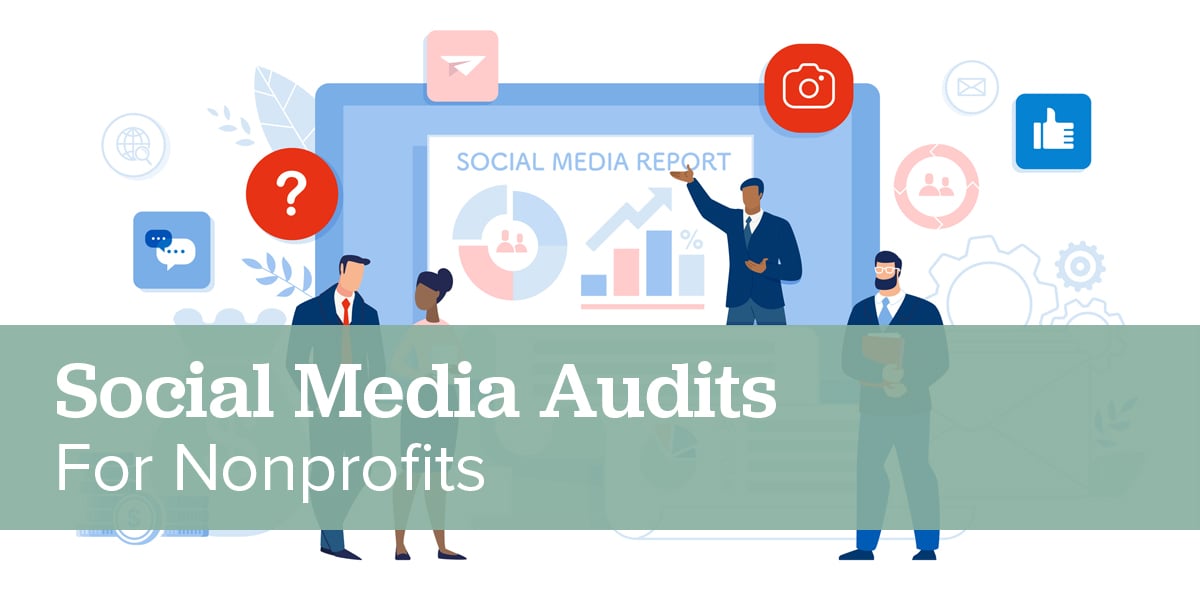
Social media has proven to be a powerhouse for nonprofit marketing. It has given us the ability to readily reach our audiences in a personable and genuine way - and it's free! For the most part, social media has provided great benefits to nonprofits. But it has also created more work and added another layer to what can already be a time-consuming marketing effort. The truth is that if social media is left to the last minute and care isn't given to it, you may need to stop and take a look at your social presence as a nonprofit. The way we recommend doing that is by conducting a social media audit.
What is a Social Media Audit?
Social media can be used in countless ways for nonprofits. Nonprofit social media platforms are used to expand brand reach, share mission and vision, and of course to reach donors and raise funds. In order to do those things, you need a strategy, and in order to develop a strategy, you need to understand what you're doing now that's working towards those goals, and what can and should be changed.
A social media audit is a lot like spring cleaning. You're taking stock of everything you've done for the last quarter, year, or campaign - and keeping what still fits, and donating the things that maybe got a little too tight - or simply don't serve your purpose. It's a comprehensive report of your activity and your results on social media. It should include any social media campaigns and strategies you've run, and the results that became of them.
How to Conduct a Social Media Audit
The purpose of a social media audit is to gain insights into your efforts on social media to ultimately determine what works and what doesn't. Your audit should include all of your social media channels so even if you haven't posted on Instagram recently, dig around and find that pesky business profile, leave no stone unturned.
Start with Data
We like to use comprehensive tools like HubSpot and SEMrush to gather every piece of data we can. Start compiling your key metrics along with the campaign goals they fell under. You should be looking at organic and paid efforts on social media so you understand how your results changed when there was money behind them.
The first part of any audit should be research-based. This means diving headfirst into your social efforts to see where you succeeded, and yes, where you may have failed or missed the mark.
Evaluate Your Performace
You've gathered your data, so, how'd you do? Measure your key metrics against campaign goals to get a full picture of if your efforts were successful. Perhaps you ran a brand awareness campaign with the goal of increasing followers - the metric you should be measuring, in that case, is, of course, followers. You could look at other awareness metrics like likes, views, and engagement as well. But try not to get distracted by other shiny metrics. If you're focused on traffic to your website, those kinds of website metrics are the ones to evaluate.
Some key social media metrics might be:
- Engagement Rate
- Likes
- Followers
- Link Clicks
- Traffic to Website
- Contact Us Clicks
An audit will help you to determine if your metrics have been improving or not and it will help to determine which metrics you should be tracking for upcoming campaigns or strategies.
Evaluate Your Audiences
You likely have a pretty good understanding of who your audiences are - for nonprofits they generally fall into one of three categories:
- Donors (corporate or individual)
- Beneficiaries
- Volunteers
You know who they are, but do you know where they are? When it comes to social media - an audit can answer that question. There is so much demographic information floating around on social platforms that can come in handy during an audit. Many social media platforms offer audience insights and don't overlook this. Understanding who your engaged audience is on each platform is key to a successful social media campaign.
Look to Your Influences and Competitors
Once you have a pretty good grasp on the above, it's time to start planning for the future of your social efforts. A good place to look for inspiration is to see what others in the industry are doing and from there coming up with creative and strategic content that's on-brand for your organization.
Locate the social pages of a few of your closest competitors and influencers across all channels and be honest about what you see that you want to emulate. You of course want to consider if their audience is the same as yours, and if so, what kinds of posts and content are getting the highest engagement?
Determine Your Goals Moving Forward
The ultimate purpose of a social media audit is to learn from your efforts and improve on them. Taking close stock of your social presence is the fastest (although it might not seem that fast) way to be successful on social media. And it's up to you to determine what success means to you. This will give you a full view of how you're performing which will make creating goals that much easier. Now it's time for action!
These will vary, but here are some examples of social media marketing goals:
- Increase Engagement
- Increase Traffic to Website from Social
- Increase Post Count
- Increase Number of Followers.
The above are general and when you set a goal, make it a SMART goal so you're able to properly measure when the time comes.
A lot of time and effort goes into a social media audit, so if you're curious about the process or want to have us do the heavy lifting, contact us today!